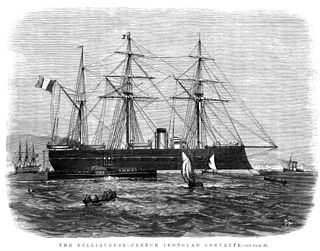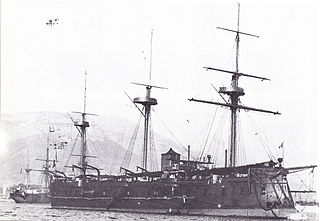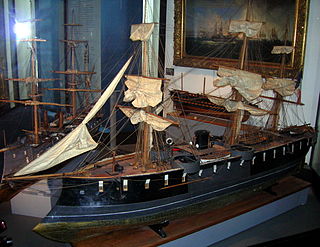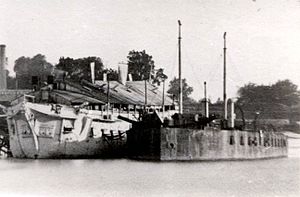
An ironclad is a steam-propelled warship protected by iron or steel armor plates, which were predominantly constructed from 1859 to the early 1890s. The ironclad was developed as a result of the vulnerability of wooden warships to explosive or incendiary shells. The first ironclad battleship, Gloire, was launched by the French Navy in November 1859. The British Admiralty had been considering armored warships since 1856 and prepared a draft design for an armored corvette in 1857; in early 1859 the Royal Navy started building two iron-hulled armored frigates, and by 1861 had made the decision to move to an all-armored battle fleet. After the first clashes of ironclads took place in 1862 during the American Civil War, it became clear that the ironclad had replaced the unarmored ship of the line as the most powerful warship afloat. This type of ship came to be very successful in the American Civil War.

The French ironclad Gloire ("Glory") was the first ocean-going ironclad, launched in 1859. It was developed after the Crimean War, in response to new developments of naval gun technology, especially the Paixhans guns and rifled guns, which used explosive shells with increased destructive power against wooden ships, and after the development of the ironclad floating batteries built by the British and French for the bombardment of Russian forts during the Crimean War.

Solférino was the second and last ship of the Magenta-class of broadside ironclads built for the French Navy in the early 1860s.

The Magenta class consisted of two broadside ironclads built for the French Navy in the early 1860s. They were the only ironclad two-deckers ever built, and the first ironclads to feature a naval ram.

Lave was an ironclad floating battery of the French Navy during the 19th century. She was part of the Dévastation class of floating batteries.

Jeanne d'Arc was a wooden-hulled armored corvette built for the French Navy in the late 1860s. She was named for Joan of Arc, a Roman Catholic saint and heroine of the Hundred Years War. Jeanne d'Arc participated in the Franco-Prussian War of 1870–71 and remained in commission afterwards, unlike many of her sisters. The ship was condemned in 1883, but nothing further is known as to her disposition.

The French ironclad Normandie was the third and last of the three wooden-hulled Gloire-class ironclads built for the French Navy in 1858–62. The ships of the Gloire class were classified as armoured frigates because they only had a single gun deck and their traditional disposition of guns arrayed along the length of the hull also meant that they were broadside ironclads. Normandie was the first ironclad to cross the Atlantic in support of the French intervention in Mexico in 1862. Although the ship was active during the Franco-Prussian War of 1870–71, she saw no action. The unseasoned timber of her hull rotted quickly; she was condemned in 1871 and subsequently scrapped.

The French ironclad Belliqueuse ("Bellicose") was a wooden-hulled, armored corvette, built for the French Navy in the 1860s and designed as a cheap ironclad. She was the first French ironclad to sail around the world, which she did between December 1867 and May 1869. She spent the bulk of her career in the Pacific before returning to Toulon, where she was used as a target in 1886.
The French ironclad Alma was a wooden-hulled armored corvette built for the French Navy in the late 1860s. The lead ship of her class, she was named after the 1854 Battle of Alma of the Crimean War. The ship spent her early career on the China Station and later supported the French occupation of Tunisia in 1881. She was condemned in 1886, but was not sold until 1893.

The French ironclad Armide was a wooden-hulled armored corvette built for the French Navy in the mid-1860s. Placed into reserve after completion, she was first mobilized for the Franco-Prussian War of 1870–71. She spent the rest of her career in the Mediterranean and then in the Far East as flagship of the French squadrons there, until her decommissioning in 1880. Armide was use as a target for gunnery trials in 1886.

The French ironclad Atalante was a wooden-hulled armored corvette built for the French Navy in the mid-1860s. She played a minor role in the Franco-Prussian War of 1870, bombarded Vietnamese forts during the Battle of Thuận An in 1884 and participated in the Sino-French War of 1884–85. Atalante was reduced to reserve in Saigon in 1885 and sank there two years later after having been condemned.

The French ironclad Montcalm was a wooden-hulled armored corvette built for the French Navy in the mid-1860s. She was named after Major General Montcalm who lost the Battle of the Plains of Abraham in 1759. She played a minor role in the Franco-Prussian War of 1870 where she captured one Prussian sailing ship. Montcalm spent most of her later career abroad, either in Chinese waters or the Pacific Ocean. The ship was condemned in 1891.

The French ironclad Thétis was a wooden-hulled armored corvette built for the French Navy in the late 1860s. She was named for the Greek sea-goddess Thetis. During the Franco-Prussian War she was assigned to a squadron of French ships that attempted to blockade the Prussian ports in the Baltic Sea in 1870. She accidentally rammed her sister Reine Blanche in 1877. En route to the Pacific in 1884 her propeller fell off and she had to return to France under sail. Thétis was eventually hulked in New Caledonia.

The Alma-class ironclads were a group of seven wooden-hulled, armored corvettes built for the French Navy in the mid to late 1860s. Three of the ships attempted to blockade Prussian ports in the Baltic Sea in 1870 during the Franco-Prussian War. Three others patrolled the North Sea and the Atlantic, while the last ship was en route to Japan when the war began and blockaded two small Prussian ships in a Japanese harbor. Afterwards they alternated periods of reserve and active commissions, many of them abroad. Three of the ships participated in the French occupation of Tunisia in 1881 while another helped to intimidate the Vietnamese Government into accepting status as a French protectorate and played a small role in the Sino-French War of 1884–85.

The Dévastation-class ironclad floating batteries were built for the attack of Russian coastal fortifications during the Crimean War. France had intended to build ten of these vessels, but in the time available was only able to construct five in French shipyards, of which the first three took part in the attack on Kinburn in 1855, and served in the Adriatic in June–July 1859 during the Italian war.

The French ironclad Friedland was originally intended to be an iron-hulled version of Océan-class armoured frigate built for the French Navy during the 1870s, but she was much altered during her prolonged construction. Named after the French victory at the Battle of Friedland in 1807, the ship spent the bulk of her career assigned to the Mediterranean Squadron and supported the French occupation of Tunisia in 1881. She was condemned in 1902.

Suffren was a wooden-hulled, armored frigate of the Océan class, built for the French Navy in the mid to late 1860s. Although she was laid down in 1866, the ship was not launched until 1870 and commissioned in 1876. Suffren was one of the French ships assigned to the international squadron gathered to force the Ottoman Empire to carry out its obligations under the Treaty of Berlin in 1880. The ship was paid off in 1895 and discarded two years later.

The Gloire-class ironclads were a group of three wooden-hulled armored frigates built for the French Navy in the late 1850s and early 1860s. Gloire, the lead ship of the class, was the first ocean-going ironclad warship to be built by any country. The ships of the Gloire class were classified as armoured frigates because they only had a single gun deck and their traditional disposition of guns arrayed along the length of the hull also meant that they were broadside ironclads.

The French ironclad Savoie was one of 10 Provence-class armored frigates built for the French Navy during the 1860s.

The French ironclad Héroïne was one of 10 Provence-class armored frigates built for the French Navy during the 1860s. She was the only ship of the class to be built with an iron hull. Completed in 1865, the ship was initially assigned to the Northern Squadron, sometimes serving as a flagship. The ironclad played a minor role in the Franco-Prussian War of 1870–1871, blockading the North Sea coast of Prussia and a Prussian commerce raider in a neutral Spanish port. Héroïne was decommissioned after the war, but was reactivated in 1876 and was assigned to the Mediterranean Squadron.












